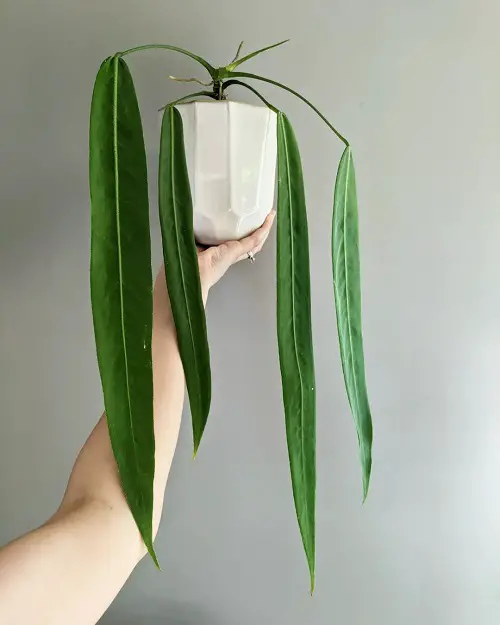If you’re looking for an eye-catching plant to liven up your space, then Anthurium Pallidiflorum is definitely the way to go!

Anthurium Pallidiflorum is a tropical plant that is sure to steal your heart with its unique charm and easygoing nature. Here’s everything you need to know about growing it!
Anthurium Pallidiflorum Information
Anthurium Pallidiflorum is a species of flowering plant in the Araceae family, which is native to Colombia and Ecuador. It grows in tropical rainforests at altitudes between 800 and 1500 meters.
The leaves of Anthurium Pallidiflorum can reach up to 20-26 inches long and 6-10 inches wide. The flowers are typically 1 to 2 inches across and have 6 to 10 yellowish-green petals. The flowers are followed by small, red fruits.
USDA Zones: 4-9
Anthurium Pallidiflorum Pot Requirement

Anthurium Pallidiflorum prefers to be a little bit snug in its pot, so choose a pot that’s just slightly larger than the root ball. You can start the plant in an 8-10-inch container, which will be good for about 2-3 years.
After that, depending on its growth and spread, keep on re-potting in one size bigger container than the old one.
Propagating Anthurium Pallidiflorum
By Division:
1. Select a mature, healthy plant with several stems and leaves.
2. Gently remove the plant from its pot and shake off excess soil.
3. Use a sharp knife to divide the root ball into two or more sections carefully.
4. Plant each section in its own pot filled with well-draining potting soil.
5. Water the soil until it is evenly moist and place the pots in a bright, indirect light.
By Seeds:
1. Fill a pot with well-draining potting soil and moisten it until it is evenly moist.
2. Place the pot in a warm, sunny spot.
3. Sow the seeds in the soil, about 1/4 inch deep.
4. Cover the seeds lightly with soil and water them gently.
5. Keep the soil moist and wait for the seeds to germinate, which can take up to six weeks.
6. Once the seedlings are large enough to handle, transplant them into individual pots filled with well-draining potting soil.
7. Water the soil until it is evenly moist and place the pots in a bright, indirect light.
Anthurium Pallidiflorum Growing Information

Sunlight
Anthurium Pallidiflorum is a shade-loving plant that prefers bright, indirect sunlight. It does not tolerate sun and should be kept out of direct light.
It can tolerate some direct morning sunlight (2-3 hours) but should be kept in a bright, indirect location for most of the day.
Watering
This plant should be allowed to dry out slightly between waterings, but not too much. Make sure the soil is moist, but not soggy. If the soil is too wet, the roots can rot, so it is important to make sure the plant has good drainage.
During the summer months, water it a little more frequently, only when the topsoil is a little dry.
Temperature and Humidity
Anthurium pallidiflorum is a tropical plant native to Central and South America. It prefers warm temperatures, with ideal temperatures ranging between 65-85°F (18-29°C). When temperatures drop below 60°F (15°C), the plant may suffer.
These plants thrive in the humidity range between 30-50%. It is important to maintain humidity levels in the environment to keep the plant healthy and thriving.
To increase humidity levels, mist the plant regularly or place the pot on a tray of pebbles and water.
Read about Anthurium Plant Care
Anthurium Pallidiflorum Care

Fertilizer
Anthurium Pallidiflorum is not a heavy feeder, so to boost its growth, a monthly dose of a balanced fertilizer diluted to half its strength is all you need. Do not feed the plant in colder months.
Pests and Diseases
Common pests that can affect Anthurium pallidiflorum include spider mites, scale insects, aphids, and mealybugs. These pests can be controlled with regular applications of insecticidal soap or neem oil.
Diseases include fungal leaf spots, root and crown rot, and botrytis. These diseases can be controlled by keeping the plant in well-drained soil, providing adequate air circulation, and avoiding over-watering. Fungicides may also be used to control these diseases.


